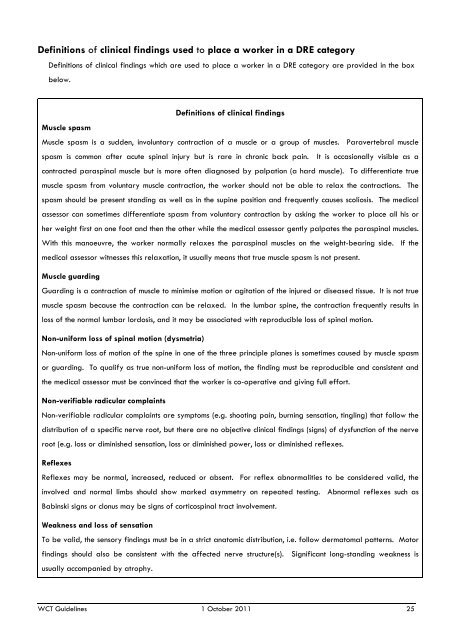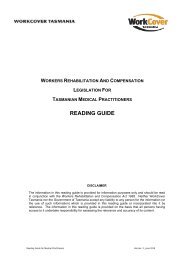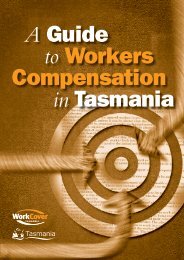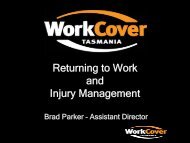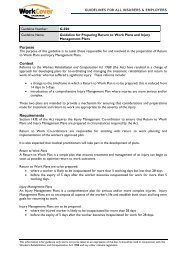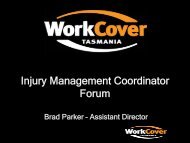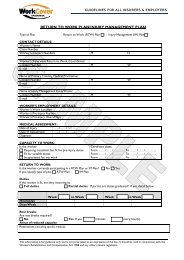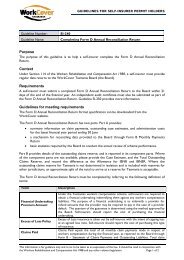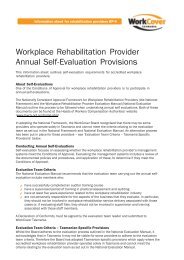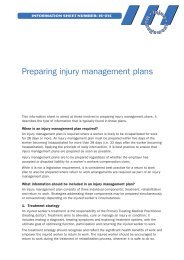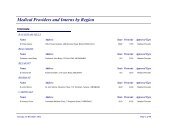Guidelines for the assessment of permanent impairment Version 3
Guidelines for the assessment of permanent impairment Version 3
Guidelines for the assessment of permanent impairment Version 3
You also want an ePaper? Increase the reach of your titles
YUMPU automatically turns print PDFs into web optimized ePapers that Google loves.
Definitions <strong>of</strong> clinical findings used to place a worker in a DRE categoryDefinitions <strong>of</strong> clinical findings which are used to place a worker in a DRE category are provided in <strong>the</strong> boxbelow.Definitions <strong>of</strong> clinical findingsMuscle spasmMuscle spasm is a sudden, involuntary contraction <strong>of</strong> a muscle or a group <strong>of</strong> muscles. Paravertebral musclespasm is common after acute spinal injury but is rare in chronic back pain. It is occasionally visible as acontracted paraspinal muscle but is more <strong>of</strong>ten diagnosed by palpation (a hard muscle). To differentiate truemuscle spasm from voluntary muscle contraction, <strong>the</strong> worker should not be able to relax <strong>the</strong> contractions. Thespasm should be present standing as well as in <strong>the</strong> supine position and frequently causes scoliosis. The medicalassessor can sometimes differentiate spasm from voluntary contraction by asking <strong>the</strong> worker to place all his orher weight first on one foot and <strong>the</strong>n <strong>the</strong> o<strong>the</strong>r while <strong>the</strong> medical assessor gently palpates <strong>the</strong> paraspinal muscles.With this manoeuvre, <strong>the</strong> worker normally relaxes <strong>the</strong> paraspinal muscles on <strong>the</strong> weight-bearing side. If <strong>the</strong>medical assessor witnesses this relaxation, it usually means that true muscle spasm is not present.Muscle guardingGuarding is a contraction <strong>of</strong> muscle to minimise motion or agitation <strong>of</strong> <strong>the</strong> injured or diseased tissue. It is not truemuscle spasm because <strong>the</strong> contraction can be relaxed. In <strong>the</strong> lumbar spine, <strong>the</strong> contraction frequently results inloss <strong>of</strong> <strong>the</strong> normal lumbar lordosis, and it may be associated with reproducible loss <strong>of</strong> spinal motion.Non-uni<strong>for</strong>m loss <strong>of</strong> spinal motion (dysmetria)Non-uni<strong>for</strong>m loss <strong>of</strong> motion <strong>of</strong> <strong>the</strong> spine in one <strong>of</strong> <strong>the</strong> three principle planes is sometimes caused by muscle spasmor guarding. To qualify as true non-uni<strong>for</strong>m loss <strong>of</strong> motion, <strong>the</strong> finding must be reproducible and consistent and<strong>the</strong> medical assessor must be convinced that <strong>the</strong> worker is co-operative and giving full ef<strong>for</strong>t.Non-verifiable radicular complaintsNon-verifiable radicular complaints are symptoms (e.g. shooting pain, burning sensation, tingling) that follow <strong>the</strong>distribution <strong>of</strong> a specific nerve root, but <strong>the</strong>re are no objective clinical findings (signs) <strong>of</strong> dysfunction <strong>of</strong> <strong>the</strong> nerveroot (e.g. loss or diminished sensation, loss or diminished power, loss or diminished reflexes.ReflexesReflexes may be normal, increased, reduced or absent. For reflex abnormalities to be considered valid, <strong>the</strong>involved and normal limbs should show marked asymmetry on repeated testing. Abnormal reflexes such asBabinski signs or clonus may be signs <strong>of</strong> corticospinal tract involvement.Weakness and loss <strong>of</strong> sensationTo be valid, <strong>the</strong> sensory findings must be in a strict anatomic distribution, i.e. follow dermatomal patterns. Motorfindings should also be consistent with <strong>the</strong> affected nerve structure(s). Significant long-standing weakness isusually accompanied by atrophy.WCT <strong>Guidelines</strong> 1 October 2011 25


